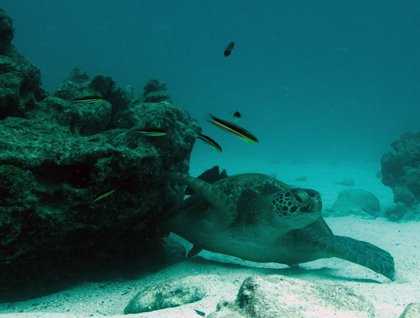After a leisurely breakfast, the walking group departed the National Geographic Islander and headed for South Plaza Island. A miniscule island off the eastern coast of Santa Cruz Island, it has an incredible collection of flora and fauna in a very small area.
Land iguanas were our objective, but we got easily side-tracked by sea lions on arrival, as the south side of the low-lying island has been divvied up into 10-12 sea lion territories. Each had its dominant male and females with pups. On the opposite side of the island, a low bluff was created when the island was up-lifted by volcanic activity. By coincidence it faces the southeast trade winds that today were strong. When the wind hits the bluff, it is forced up fast, creating an up-draft favored by all kinds of sea birds in the area. Swallow-tailed gulls, Galapagos shearwaters, magnificent frigate birds, blue-footed boobies and the stars of the show: the red-billed tropicbirds with the streaming tail feathers in glorious exuberant courtship excess. But one far corner seems reserved for the bachelors. The males who don’t have territories, are too old, too tired, or too wise to waste energy before it’s really time to breed. They enjoy the company of their own kind, so when not actively involved in territorial disputes, look for peaceful places to hang out together, with no stress, no challenges.
Holding onto our hats, the trail follows the top edge of the cliff (not too close!), and below we could see schools of surgeonfish and mullet clamoring at the surface for the upwelled plankton being pushed against the cliff base.
South Plaza has a population of around five hundred endemic land iguanas. They are regal looking, with perhaps even a disdainful, or reproachful gaze when they look at us - if I am allowed to anthropomorphize. Beautiful animals, they are perfect for photographic composition against the bark of the prickly pear cactus sea purslane or grey mat plant. While we were focused on several of these, Juan Carlos caught movement out of the corner of his eye and found a short-eared owl coming out of its den at the base of the shrub line. THAT was an unexpected bonus!
The afternoon was spent at Santa Fé Island to the southeast of Santa Cruz Island. For millennia, another species of land iguana (of a much paler coloration) have lived here. Santa Fé is considered one of the oldest islands of the archipelago, and apart from its own endemic species of land iguana, the island also used to have its own species of giant tortoise. The downside of being an island with easy access through a beautiful bay of turquoise water and two matching golden beaches, is that the tortoises disappeared a couple hundred of years ago, taken for food by pirates and whalers. When goats were introduced later by fishermen, they replaced the tortoises as the primary herbivore in the island’s ecosystem. However once the goats themselves were eradicated in the late 70s, it was acknowledged that the island’s ecosystem would be out of balance if something wasn’t done. And something was done just recently, this past June, when the Galapagos National Park released over one hundred young tortoise hatchlings here to grow and eat as much as they can. Not the original species of course, these youngsters come from Española parents and were hatched and raised at the Fausto Llerena Tortoise Rearing Center on the island of Santa Cruz. The Española tortoises have been so prolific over the last two decades that the National Park has already been able to repopulate their home island of Española with over two thousand tortoises. With other islands becoming desperate for ecological balance through grazing by a large herbivore, the release of these little hatchlings is a wonderful solution all round.
Galapagos hawk, Galapagos rice rat, Galapagos land iguana, Santa Fe land iguana, Scalesia helleri, Opuntia echios var. barringtonensis and Galapagos sea lions made the afternoon visit on land well worth the time. Previously we had been snorkeling in the bay and saw a beautiful marine turtle quietly resting on the white sand bottom while the kayakers made the grand circuit of the bay.
Pretty fabulous day!







